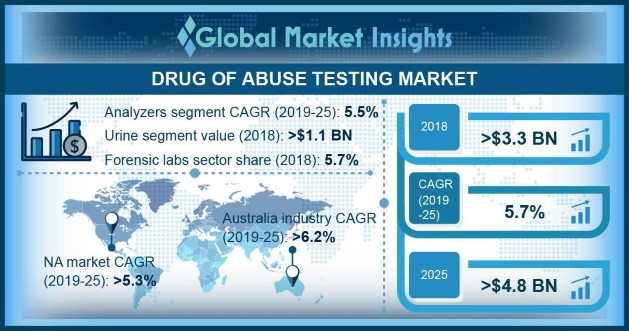Home > Healthcare > Medical Devices > Diagnostic Devices > Drug of Abuse Testing Market
Drug of Abuse Testing Market Size
- Report ID: GMI4409
- Published Date: Oct 2019
- Report Format: PDF
Drug of Abuse Testing Market Size
Drug of Abuse Testing Market size surpassed USD 3.3 billion in 2018 and is projected to achieve over 5.7% CAGR up to 2025.
Drugs of abuse are chemicals that generally produce specific effects in the user’s brain, mainly in reward circuitry of brain. In general, drugs of abuse either produce good feelings or relieve bad feelings within seconds to minutes after administration. Drugs can be administered by various routes such as inhalation, oral ingestion, oral absorption, subcutaneous, intravenous or intramuscular injection, and others. Generally, drug tests do not detect drug use. Instead, drug tests identify specific drug classes or drugs in biological matrices that are represented in particular test panels. Drugs can be detected using any sample, the most common samples for usual testing purposes include blood, urine, hair, oral fluid, nails, breath and sweat.
Drug testing was widely used in the U.S. in 1950s in hospital emergency rooms to rapidly diagnose and treat patients with drug overdose. With the development of thin layer chromatography, testing for drugs of abuse with urine sample became feasible in large populations. In 1970s, the development of automated immunoassay technologies conducted in laboratories allowed large scale urine drug testing in the criminal justice system and addiction treatment. Immunoassay was the first drug testing technology to be automated. In 1980s, in context of the cocaine epidemic, drug testing became widespread in the civilian workforce to discourage drug use that could impair workforce safety and productivity.
| Report Attribute | Details |
|---|---|
| Base Year: | 2018 |
| Drug of Abuse Testing Market Size in 2018: | 3.3 Billion (USD) |
| Forecast Period: | 2019 to 2025 |
| Forecast Period 2019 to 2025 CAGR: | 5.7% |
| 2025 Value Projection: | 4.8 Billion (USD) |
| Historical Data for: | 2014 to 2018 |
| No. of Pages: | 220 |
| Tables, Charts & Figures: | 215 |
| Segments covered: | Product, Sample, End-use and Region |
| Growth Drivers: |
|
| Pitfalls & Challenges: |
|
Furthermore, in the 21st century, testing of drugs became increasingly widespread. The drug testing was added to alcohol testing for drivers arrested for being impaired and involved in serious accidents. Presently, testing for drugs of abuse in medical practice is rapidly growing in the area of pain management. This is majorly due to the increased use of opioids to treat chronic pain as well as morbidity and mortality related to the misuse of these drugs.

